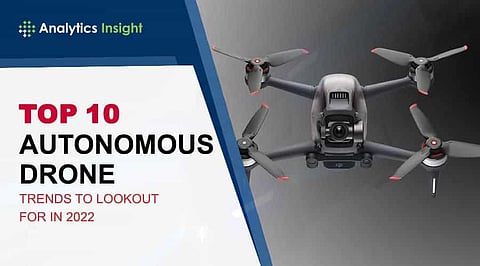

An autonomous drone is capable of flying safely without the assistance of a pilot. It accomplishes this with the assistance of artificial intelligence, which enables it to deal with a wide range of unexpected and unanticipated emergency scenarios. The autonomous drone has achieved the highest level of 3D aerial autonomy to date. It can perform complex transportation, distribution, security, inspection, and research duties, as well as novel collaboration modes with other drones and land-based robots. Drones' utility has risen dramatically in recent years, because, unlike human aircraft, they can fly or function in the air for extended periods. They're also less expensive than military planes, ships, or ground vehicles, and there's no risk of the operations crew losing their lives.
Except for military uses, aerial photography and videography, and recreational usage, drone acceptance has been modest in the 10 years since the Federal Aviation Administration (FAA) awarded the first commercial drone permits in 2006. The worldwide commercial drone industry is expected to reach US$17 billion by 2024, according to Global Market Insights.
One of the primary areas that have profited from the deployment of the autonomous drone is agriculture. Drones can swiftly map regions and sprinkle water or fertilize farms. Farmers may employ robotic drones with sensors to collect a significant amount of big data, which they can use to control risk and enhance agility. The autonomous drone is also less expensive since they utilize fewer chemicals. Drones can assist farmers to speed up time-consuming and expensive operations like inventorying crops, irrigation, and animal health monitoring.
Drones might potentially assist minimize worker deaths and injuries in some high-risk occupations. Roof inspections are one duty that drones can perform more safely than humans, according to Inc., which adds that every year, approximately 50 roofers are died on the job, with countless more wounded.
The autonomous drone has a new use in healthcare and for emergency responders, according to Business News Daily using drones to gain eyes on a dangerous scenario or to deliver medical supplies to trapped patients might improve emergency response physicians' capacity to provide care in dangerous situations. Zipline, a US company, has already used drones to transport vaccinations and blood in Rwanda and Ghana.
Drones are being eyed by several big corporations as a way to improve internet access, particularly in rural regions. According to Business News Daily, Facebook bought solar-drone firm Titan Aerospace five years ago to deliver internet connectivity to the developing globe with the Aquila drone.
Some drones are planes that don't have pilots on board. Those drones are used for surveillance, data collecting, and threat detection without regard for hostage situations or the pilot's safety. The need for an autonomous drone for border patrols, paramilitary groups, and police to combat drug trafficking and other crimes is growing all the time. Airstrikes, surveillance, traffic monitoring, rescue and search operations, bomb threats, hostage situation handling, and fugitive tracing are just a few of the military uses for the autonomous drone. Government agencies are using this technology to combat urgent circumstances, so drones do not represent a threat to human life.
The primary motivation for unmanned undersea vehicles (UUVs) is safety. When more UUVs are deployed, fewer humans are required to work in potentially hazardous underwater situations, such as manned submarines or diving gear. UUVs are used by the Navy to detect mines, find submerged obstructions and wrecks, map ocean floors, and photograph underwater archaeological sites. UUVs are also used in the maritime industry for offshore oil production and exploration. The offshore oil sector frequently works in deep and hazardous coastal seas, posing a significant risk to human life. By remotely maintaining and inspecting pipes, cleaning up trash, and aiding in drilling, robotic underwater vehicles help the industry save money and keep its personnel safe. This trend is projected to continue for the next five years, boosting demand for both military and commercial UUVs.
Many news organizations use drones to film and broadcast events, which has proven to be a simple and cost-effective activity. Drones are fitted with cameras that allow them to fly lower and into tighter spaces than bigger human aircraft. Drones' viewers get a glimpse from the drivers-side window of a fast automobile on the news, but helicopters only give vast aerial views during high-speed pursuits.
In terms of lethal force, drones assist in tackling and even destroying missiles, resulting in less collateral damage than other weapons systems. Drones deliver a pinpoint, targeted, covert strike to keep the conflict zone from expanding. Furthermore, removing pilots from combat zones entirely reduces the risk to their lives. Drones are controlled from facilities far away from the battleground, allowing their operators to make better targeting judgments because they are not concerned about their safety. Drones also contribute to a reduction in civilian deaths.
There's even Drones-as-a-Service (DaaS) if you're thinking about purchasing a drone for your business. Measure pioneered this solution, which is similar to Software-as-a-Service (SaaS), to assist organizations to decrease the risks and expenses of adopting this technology.
The autonomous drone has a lot of promise for Amazon's delivery service. Customers will receive their products in 30 minutes or less, according to Prime Air. According to Amazon, Prime Air has a lot of potentials to improve the services the firm already delivers to millions of consumers by allowing for faster parcel delivery, which will improve the transportation system's overall safety and efficiency. Amazon is expected to roll out the service in a few locations over the coming few months.
Join our WhatsApp Channel to get the latest news, exclusives and videos on WhatsApp
_____________
Disclaimer: Analytics Insight does not provide financial advice or guidance. Also note that the cryptocurrencies mentioned/listed on the website could potentially be scams, i.e. designed to induce you to invest financial resources that may be lost forever and not be recoverable once investments are made. You are responsible for conducting your own research (DYOR) before making any investments. Read more here.
